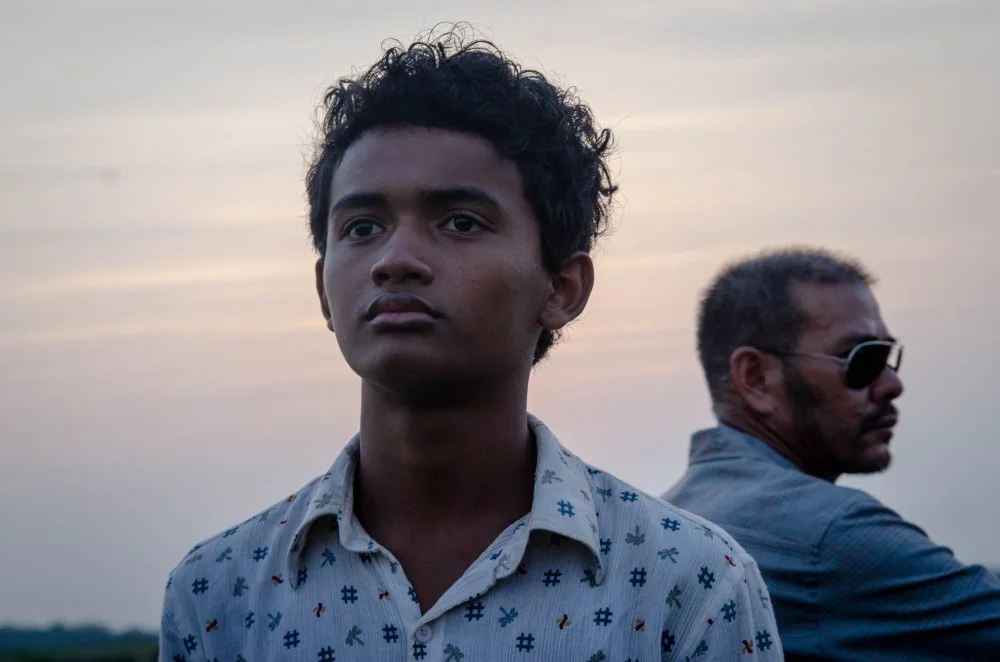arm Heng as Chakra with Thanawut Kasro as Rom Ran in Buoyancy
By André Crous
There have never been more slaves in the world than there are at present, in 2019. The final title card of Rodd Rathjen’s strong debut feature, Buoyancy, informs us that some 200,000 of them are trapped in Southeast Asia.
The ones we meet here represent but a drop in the ocean, but their story is simple enough to comprehend. It also clearly represents the broader range of experiences among the region’s workers often held captive in inhumane conditions. Based on the experiences of many real-life (presumably former) slaves in the region, the story follows the journey of a Cambodian teenager named Chakra (newcomer Sarm Heng) facing the grim reality of life as a slave in the 21st century.
The film has beautiful bookmarks: In the opening shot, we see the back of Chakra’s head. He is carrying a heavy bag across his shoulders, and his shirt is drenched with sweat in the tropical heat. He is heading down a road. In the final shot, we see his face as walks down the same road, his life now completely changed. The events that mark this transition, however, are anything but innocuous.
Buoyancy’s opening minutes broadly sketch Chakra’s domestic situation as one that seems like the beginning of a decades-long dead-end. Living with his parents and multiple siblings under one roof is difficult enough, but Chakra knows things will never get better for him out here in the rice fields of Cambodia. He learns from his football buddies that it’s possible to escape the village for a better life in neighbouring Thailand.
Since he doesn’t have the money to pay a smuggler, he agrees to work for free for the first month. But instead of going to a pineapple factory like the others, he ends up on a boat where time stands still. Underscoring their grim social position are the fish they have to sort through, which are destined to be turned into dogfood. The notion of getting paid anything more than a bowl of rice at the end of a gruelling day of work is one his violent Thai captors, led by Captain Rom Ran (Thanawut Kasro), clearly do not share.
Chakra shows remarkable maturity, or maybe it is his inscrutability that makes him seem less childlike. Despite the hopelessness of this situation, which drives some of his fellow slaves to despair, he perseveres by working as hard as he can. When he realises there will never be a salary at the end of the month, he seeks any way possible to make life bearable and, especially, to rise through the hierarchy among the workers, many of whom are Burmese and stick together against him – an outsider among outsiders.
His expressionlessness saves him because he is not as easy to read as his countryman, Kea (Mony Ros). Kea has a family and wants to send money back home to his children. He senses the danger early on and does his best to protect Chakra as well as his fatherly instincts can, but he also demonstrates how dreams unfulfilled can lead to tragedy. By contrast, Chakra appears not to daydream. He keeps despair at bay by always remaining focused on the present. And when opportunity comes knocking, he is quick to seize the moment and change the future.
Rathjen mixes a documentary approach, including a very mobile camera, with a more artistic sensibility that can sometimes seem dreamlike. Brief moments of respite from the horror include the camera seemingly suspended from the clouds as it looks down at the ship passing below us, framed by the blue-green waters of the Gulf of Thailand, or when Chakra spends a rare moment floating in the water at sunset.
Although deeply satisfying to viewers wound tight as a drum after more than an hour of Chakra’s harrowing and seemingly hopeless fate, the film’s final act seems like wishful thinking. Despite his lack of experience outside the bubble of his small town, he doesn’t make a single mistake out on the boat. Somehow, the sea gods smile on his predicament and allow him to take control of his destiny without much pushback. He reveals himself to be buoyant, able to rise up from intense turmoil, and he doesn’t even get stained by the dirty froth on top.
The sharp focus on Chakra, who appears in every single scene, draws us into his story regardless of whether we feel we understand him. Although a couple of the scenes are haunting because of their implicit inhumanity (the dismemberment of one of the slaves is particularly tough to watch), Buoyancy does not engage in gratuitous violence. Its mostly taciturn central character stoically confronts the tribulations on board without contriving a drama that might justify a strong reaction. And as a result, the realisation of injustice dawns all the more forcefully on us as we leave the cinema.
Viewed at the 2019 Berlin International Film Festival.
—
Country Australia
Released 2019
Director(s) Rodd Rathjen
Producer(s) Kristina Ceyton, Samantha Jennings, Rita Walsh
Screenwriters Rodd Rathjen
Directors of Photography Michael Latham
Stars Sam Heng, Thanawut Kasro
Running Time 93 minutes
André Crous is a professional film critic and a member of FIPRESCI. He holds a French honour’s degree, two master’s degrees and a Ph.D. His research examined the works of Francois Truffaut, Mikhail Kalatazov, Martin Scorcese, Paul Thomas Anderson and Michael Winterbottom. He writes about movies in his blog, Celluloid Paradiso and lives in Prague, Czech Republic. | Read More ⟩



